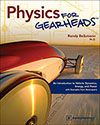|
Now Available! |
Physics for Gearheads
Price: $119.95
|

Simanaitis Says - June 1, 2015
PHYSICS FOR GEARHEADS
MY HIGH-SCHOOL physics teacher liked cameras. Following his whims, and not any school board guidelines, I came away with a deep appreciation for optics. He evidently hated levers. And, to this day, despite a Ph.D. in the mathematics of dynamic systems theory, I am baffled by simple mechanical devices that would be easy-peasy for a balanced first-year student of physics.
Have I got a book for me!
Beikmann's Ph.D. is in mechanical engineering. He's a specialist in NVH (noise, vibration and harshness) at GM's Milford Proving Grounds. And he credits his high school physics teacher with getting him started in the right direction.
The Physics for Gearheads topics are standard ones: Kinematics (movement in a straight line), Dynamics (forces, mass and acceleration), Energy (work, motion, heat and the First Law of Thermodynamics), Power (getting work done), and Statics and quasi-statics (center of gravity, weight distribution and load transfer). Chapters of non-trivial motorsports applications follow the theory, and these make Beikmann's book even more special.
Nor does he shy away from formulae. Rather, he begins intuitively, then builds on this. For instance, in the Kinematics chapter, he defines average speed as the total distance traveled divided by the time it took to do it: S Avg = d total /t. In the next chapter, Kinematics Applications, he extends this idea to analyze why Formula 1 engines can rev 18,000 rpm while NASCAR engines are kept to around 9500. (Hint: The section's subtitle is "Different Strokes.")
Beikmann assumes no formal knowledge of calculus. Instead, he appeals to its underlying idea of change, represented by Δ. Pre-calc readers aren't put off by dv/dt and the like; those with calculus background know where he's headed and will appreciate the sharpening of intuition.
The book collects key formulae at the end of each chapter. It also contains six Appendices, one of which offers selected derivations of formulae using calculus.
I enjoy Beikmann's putting things in historical perspective: Sir Isaac Newton, of course, makes several appearances. So too does French natural philosopher Sadi Carnot, whose 1824 analysis of "heat engines" offered the concept of Carnot Cycle, what Beikmann calls "the theoretical gold standard of engine efficiency."
Beikmann's writing is concise. Concerning the First Law of Thermodynamics, he says, "Knowing that energy cannot be created or destroyed gives you a very clear and powerful way to look at physics." The illustrations are clear (and occasionally witty): High-performance acceleration is exemplified by a Porsche 911. The physics of a car being towed uses a Tribant.
I like Beikmann's approach to learning: "Regardless of your background, 'soak time' is important... So while a lot of this book is about speed, reading it is not. Take your time, and enjoy it!"
Last, there's hardly any optics. ds

Review from and courtesy of Simanaitis Says - June 1, 2015
![[B] Bentley Publishers](http://assets1.bentleypublishers.com/images/bentley-logos/bp-banner-234x60-bookblue.jpg)
